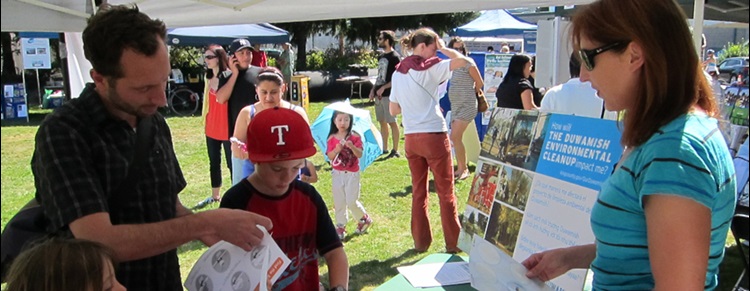
The Duwamish Waterway has historical sediment contamination from past development practices. Once it is contaminated, it is hard and expensive to clean up. Collectively, utility rate payers and tax payers (all of us) will need to invest millions of dollars in a plan to clean it up.
Keep your car well-maintained
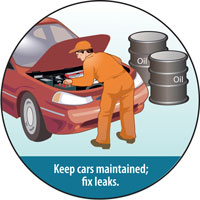
WHY?
Vehicles can account for a lot of air and water pollution, but less so if they are well-maintained.
HOW?
Maintain with regular tune-ups and fix fluid leaks. Recycle used oil and dispose of oil filters and antifreeze properly. Never pour anything but clean water down a storm drain, since most drains go straight to streams or rivers. Get vehicle-emission checks in designated areas. Close the loop by using re-refined oil. Wash your car at an approved commercial car wash. If you do wash it at home, park it on gravel or grass and use a shut-off hose nozzle and phosphate-free soap. Keep litter bags in the car and use them. Learn more about how to protect Washington Waters.
Better yet, take public transportation, such as King County Metro.
Related information
Car Maintenance Toolkit, Washington State Department of Ecology
Put trash in a trash can, not the toilet
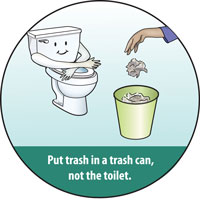
Why put trash in a trash can, not the toilet? Trash, hair and grease in the sewer pipes might cause an overflow which can harm human health and the Puget
Sound. Wastewater treatment plants use natural processes to turn dirty water into clean water and fertilizer before it is returned to the environment. Not all chemicals found in medicines, cleaners and personal products can be removed during treatment.
How to dispose of trash properly:
- Don't put grease, fats, or oil of any type down your drain or garbage disposal.
- Think trash not toilets. Flushing the wrong thing down the toilet damages your household plumbing, your environment and the wastewater treatment system. If it isn't biodegradable, put it in the trash instead of the toilet.
- Choose natural, simple, biodegradable products and help keep chemicals out of our environment. Nothing disappears – drains and toilets are the first step to a clean Puget Sound.
Properly dispose of pet waste
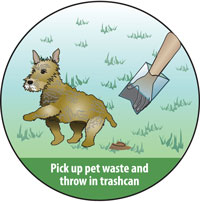
Pick up pet waste and throw it in a trashcan.
Why properly dispose of pet waste? Pet waste can be a health risk to pets and people, especially children. Pet waste is full of bacteria that can make people sick. Unless properly taken care of, pet waste and its bacteria is washed by rain into our storm drains, and is carried into our waterways without treatment. This waste can get into shellfish, potentially making people who eat shellfish sick.
How you can get rid of pet waste and help keep our waters clean: Scoop it up, seal the waste in a plastic bag and throw it in the garbage. (Be sure that this is legal in your area.) You may also bury small quantities in your yard where it will decompose slowly.
Choose natural, simple products
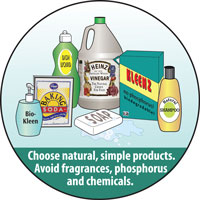
Choose natural simple products. Avoid fragrances, phosphorus and chemicals.
WHY?
Choosing environmentally friendly, biodegradable household cleaning and personal care products minimizes the entry of harmful chemicals into the wastewater stream and the environment.
Tips on finding the safest household products
-
Look at the warning words on the label. The warning words "Caution" and "Warning" indicate a moderate hazard. The words "Danger" and "Poison" on the label indicate highest hazard. Avoid products marked "Danger" or "Poison" and look for products with no warning words. Note that particular warning words don’t always refer to the same kind of hazard.
-
Chose a product with no scent or a mild scent. Scented products can add chemicals to the indoor air environment and may be toxic to children and to people with respiratory ailments or sensitive skin.
-
Check the product’s ingredients. Finding out what’s in a product can sometimes be difficult because manufacturers aren’t required to list all the ingredients (except for food products).
-
Follow the instructions for product use. Information on the product label tells how to properly use the product, how to store it and clean it up, and how to avoid water pollution and environmental harm.
Use or Make Safer Alternatives
Safer alternatives can be substituted for many products that contain hazardous ingredients, particularly for products used to clean drains, toilet bowls, ovens, bathtubs and tiles. Learn more by visiting the Local Hazardous Waste Program in King County.
Yard and lawn care
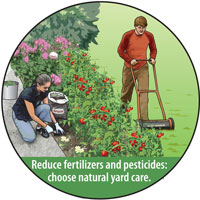
Reduce fertilizers and pesticides; choose natural yard care.
Think twice before using pesticides or herbicides. According to the United States Geological Survey (USGS), 16 pesticides have been detected in the Northwest at levels that exceed standards set to protect aquatic life.
Start with prevention
- Build healthy soil with compost and mulch.
- Select pest-resistant external link plants, and plant them in the sun and soil conditions they like.
- Remove diseased to reduce the number of hiding places.
- Pull weeds before they go to seed and spread.
- Use a variety of plants; if pests attack one plant, others can fill its place.
More information on pesticide use:
Why reduce fertilizers? Fertilizer isn't a problem - if it's used carefully. If you use too much fertilizer or apply it at the wrong time, it can easily wash off your lawn or garden into storm drains and then flow untreated into waterways.
How can you fertilize and help keep our waters clean? Use fertilizers sparingly. Many plants do not need as much fertilizer or need it as often as you might think. Don't fertilize before a rain storm. And consider using organic fertilizers; they release nutrients more slowly.
For more information on fertilizing alternatives: Contact the Washington State University Extension King County Master Gardener Program
Don't dump anything in a storm drain
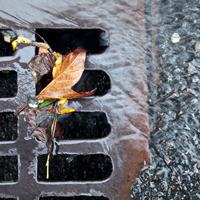
Storm drains lead to lakes and streams.
Storm drainage systems are designed to decrease the chance of flooding in areas that have been developed with homes, businesses, and roads. The rainwater that used to seep into vegetated areas now must be collected and carried elsewhere. The storm drainage system collects this storm water runoff and carries it to the nearest wetland, lake, stream, or to Puget Sound. In urban areas the storm drainage system consists of drains and underground pipes. Storm drains are normally located in streets and parking lots. In rural areas the storm drainage system may be in the form of ditches that carry the stormwater along a roadside or piece of property. These drainage systems are meant to carry only unpolluted stormwater to the nearest natural body of water. Putting oil, antifreeze, detergents, and other material into the storm drainage system is the same as dumping them directly into a lake or stream.
The sanitary sewer system is different. Sanitary sewer drains lead to the sanitary sewer system and end up at a wastewater treatment plant. This system carries household wastewater and some permitted industrial wastewater. The wastewater in this system is treated before being discharged into a natural water body.
Keeping pollutants out of the water isn't just a good idea - it's the law. The Washington State Water Pollution Control Law (RCW 90.48) and the King County Code (KCC 9.12) prohibit the discharge of pollutants to the storm drainage system, surface water and groundwater. Direct dumping of material or polluted stormwater can negatively affect every water body it enters. Pollution can cause: algal blooms that cause taste and odor problems and impaired recreation and aesthetics; lesions and tumors in fish and other animals; destruction of fish spawning areas and other habitat for plants and animals; decrease in fishing, swimming, and boating opportunities.
Many people know that it is illegal to dump toxic chemicals or other material down a storm drain. But you also are polluting if you allow pollutants to be washed into a storm drain with stormwater runoff or with wash water. For instance, you may be polluting if you:
- allow wash water from engine or equipment or car washing to enter a storm drain;
- spill antifreeze or other material without cleaning it up;
- allow materials or wastes stored outside to leak on the ground; or
- clear land without taking steps to prevent erosion.
How to get involved in the watershed
-
Visit the Our Green/Duwamish Blog and learn more about the Green/Duwamish Watershed Strategy.
-
Duwamish Waterway Roundtable Learn more about the cleanup effort by following the EPA’s Lower Duwamish Waterway Roundtable’s regular meetings.
-
Volunteer at Duwamish Alive - a coalition of nonprofit groups and government agencies dedicated to improving the health of the Duwamish River for the people and wildlife that share it.
-
Duwamish River Cleanup Coalition - Connect with community members who are involved with their river cleanup as part of the EPA’s Technical Advisory Group through the DRCC.
-
Environmental Coalition of South Seattle - A non-profit organization working with Puget Sound businesses and neighborhoods for a clean, environmentally responsible community. ECOSS provides environmentally oriented education, technical resources and other services. Site provides information about the Duwamish corridor, its cleanup, and pollution prevention.

 Translate
Translate